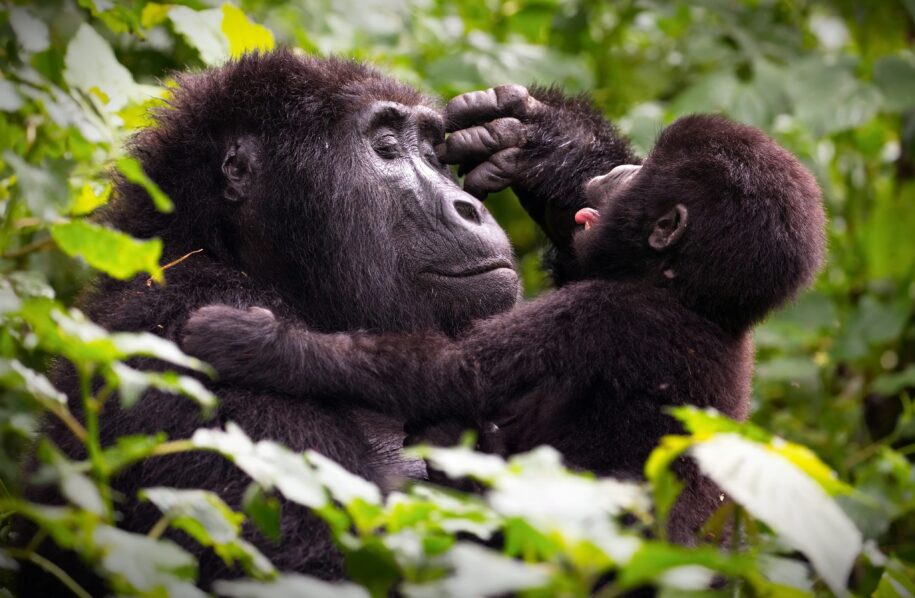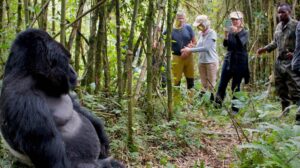Gorilla trekking represents one of the most tightly regulated forms of wildlife tourism in the world. The experience is carefully designed around the welfare of the species.
Visitors receive a single hour with a habituated gorilla group. This restriction applies regardless of group size, permit type, or tracking location.
The one-hour limit often prompts speculation. Some interpret it as a logistical decision. Others view it as a way to create exclusivity.
This policy originates from conservation science. It reflects decades of field research, health monitoring, and evolving tourism protocols.
Background on Gorilla Trekking
Gorilla trekking operates in only three countries: Rwanda, Uganda, and the Democratic Republic of Congo. Each hosts a portion of the remaining mountain gorilla population.
In Rwanda, trekking takes place within Volcanoes National Park. Uganda offers treks in Bwindi Impenetrable National Park and Mgahinga Gorilla National Park. In Congo, it occurs in Virunga National Park.
All treks are conducted with habituated gorilla groups. These are wild gorillas that have undergone a multi-year process to become accustomed to limited human presence without altering natural behaviours.
Permits are issued by national wildlife authorities. Daily quotas remain fixed to control human-gorilla contact. Each gorilla family can receive one group of visitors per day.
A standard trekking day begins with a briefing at the park headquarters. Guides assign groups based on fitness levels and known gorilla locations. Treks vary in duration, sometimes taking several hours to reach the family.
Once a group locates the gorillas, the one-hour limit begins. This timing is precise and enforced. The experience ends once the hour concludes, regardless of the gorillas’ activity or position.
This structure balances access with conservation. It allows limited observation while minimising cumulative stress and health risks for each gorilla group.
Having outlined the logistical and ecological framework, we now turn to the core reasons behind the one-hour restriction, beginning with disease transmission.
1. Disease Transmission from Humans to Gorillas
Mountain gorillas are genetically similar to humans. This similarity increases their vulnerability to human respiratory viruses, including influenza, rhinovirus, and coronavirus strains.
Unlike humans, gorillas lack the immune defences to manage many common pathogens. Even minor infections in people can lead to severe illness or death in gorillas.
Research teams have documented several outbreaks of respiratory disease in habituated gorilla populations. These incidents often correlate with periods of increased human access.
Gorillas can contract viruses through close-range exposure. Pathogens may transfer through breathing, talking, or coughing—even without physical contact.
The risk increases with time. Longer exposure means more opportunities for viral particles to spread between people and gorillas.
Health protocols now require masks and minimum distances. However, controlling time spent near gorillas remains the most effective method for reducing disease transmission.
Veterinary organisations such as Gorilla Doctors conduct post-mortem examinations and monitor health trends. Their data consistently links human contact to respiratory illness in habituated groups.
Tourism authorities, in coordination with conservation bodies, introduced the one-hour limit as a preventive measure. It remains a key policy across all mountain gorilla trekking regions.
2. Stress and Behavioural Impact on Gorillas
Mountain gorillas respond to human presence. Even when habituated, they remain sensitive to unfamiliar sights, sounds, and movement.
Field staff monitor gorilla behaviour closely during visits. Indicators of stress may include displacement, vocal changes, withdrawal from feeding, or protective positioning by dominant males.
Prolonged proximity can disrupt routine behaviours. Feeding, resting, and social interaction patterns may change during and after extended observation periods.
Habituation does not eliminate stress. It allows gorillas to tolerate brief human presence without fleeing or becoming aggressive. Tolerance does not mean the absence of physiological or psychological impact.
Group structure also plays a role. Infants, pregnant females, and newly subordinate males show higher reactivity to prolonged human presence.
Behavioural studies from Volcanoes and Bwindi National Parks support time-restricted viewing. Gorillas resume normal behaviour more quickly following shorter visits.
The one-hour rule limits cumulative stress. It prevents extended exposure that could influence group cohesion, feeding patterns, or natural movement.
Guides also receive training to interpret stress signals. They adjust group positioning or end visits early if necessary.
The goal is to reduce behavioural interference while still allowing controlled observation. Structured time limits form part of that operational framework.
3. Conservation Ethics and Sustainable Tourism
Tourism policies in gorilla range states follow conservation-first principles. Wildlife authorities design access protocols to minimise ecological disturbance and support long-term species viability.
Structured time limits form part of those protocols.
The International Union for Conservation of Nature (IUCN) provides best-practice guidelines for great ape tourism. These include specific restrictions on group size, viewing distance, and time.
All three national programs, Rwanda, Uganda, and the DRC, align with those recommendations. The one-hour limit remains standard policy across their gorilla parks.
This structure also addresses cumulative impact. Gorillas typically receive one visitor group per day. Without a time limit, that interaction could extend well beyond what is considered safe.
Revenue from permits funds veterinary services, park operations, and community programs. However, financial value does not override ecological safeguards.
Habituation allows access, but only under controlled conditions. Time restriction ensures gorillas remain subject to their behavioural rhythms, not human schedules.
Tourism here operates under a restricted-access, low-impact model. The objective is continued species survival, not maximised exposure.
Field teams, rangers, and ecologists agree: restricting time reduces long-term pressure on the gorilla groups. That principle guides all regulated gorilla tourism.
4. Logistical and Safety Considerations
Gorilla trekking involves remote movement through forested mountain zones. Terrain can be steep, uneven, and physically demanding.
Trek durations vary depending on the gorilla group location. Some may take less than one hour; others may extend beyond four.
Rangers and trackers guide each group through paths that change daily. They adjust routes to reduce disturbance and avoid crossing gorilla movement corridors.
Once trackers locate a group, they communicate the position via radio. Guides then move guests to the site and begin the regulated viewing period.
The one-hour limit creates a predictable window for teams to manage movement in and out. This allows enough time for descent before nightfall.
Rain, fog, and limited visibility increase difficulty and risk. Time restrictions help maintain a buffer for unplanned delays or environmental changes.
Limiting exposure also reduces cumulative noise, scent, and proximity from multiple groups over a day.
Park authorities enforce maximum group sizes and route spacing. These controls reduce the risk of overlap and support clear operational oversight.
Efficient time use allows rangers to monitor additional groups, check on wildlife movements, and return safely to base.
5. Enforcement of the Rule and Trekking Etiquette
Wildlife authorities train rangers to implement time restrictions without exception. Timing begins the moment a group arrives within visible range of the gorillas.
Each ranger carries a timekeeping device to ensure consistency. They monitor the group’s conduct and maintain the required distance of seven meters.
The one-hour limit does not adjust for late arrivals or difficult viewing conditions. If a gorilla moves out of sight, the clock continues.
Rangers issue clear instructions throughout the visit. They control movement, noise levels, and positioning to limit disturbance to the group.
Park rules prohibit eating, smoking, and loud conversation. Photography is allowed, but flash use is strictly banned.
Participants must remain in a tight group. Sudden movements or physical approaches toward the gorillas result in immediate intervention.
Anyone showing signs of illness is not permitted to join a trek. Rangers have full authority to deny access at any stage.
Masks are mandatory in most gorilla tourism programs. They reduce the risk of airborne transmission during close-range observation.
Violations of protocol may lead to permit revocation. Repeat offences can result in permanent exclusion from protected areas.
Compliance with guidelines allows conservation teams to maintain controlled access. This protects the gorillas while permitting continued observation under structured conditions.
The Impact of the Rule
Health Outcomes
Conservation monitoring teams report greater health stability in habituated groups since implementing structured time restrictions.
Respiratory infections remain a concern, but their frequency decreases when rangers enforce strict contact protocols.
Veterinary reports confirm fewer virus-related fatalities in gorilla groups exposed to shorter, controlled visits.
Behavioural Stability
Gorillas exposed to one-hour visits return to normal activities more quickly than those observed during extended viewing.
Field staff record fewer stress displays during short visits, including reduced chest-beating, displacement, and vocalisation.
Habituation studies show higher tolerance and lower avoidance when visits follow IUCN-recommended duration limits.
Population Trends
Mountain gorilla populations in the Virunga Massif and Bwindi have shown gradual increases over the past two decades.
Time restrictions form part of a broader conservation strategy that includes anti-poaching, veterinary intervention, and controlled habituation.
Long-term survival models rely on maintaining minimal disruption during permitted observation.
Tourism Viability
Permit revenue remains steady despite the one-hour cap. Visitor satisfaction correlates more strongly with access quality than with time length.
Authorities have not observed a drop in permit demand attributable to the time limit.
Trekking models demonstrate that ethical restrictions do not compromise economic sustainability when policy and visitor expectations are aligned.
Policy Review and Adaptation
Wildlife authorities continue to assess field data from ranger reports, veterinary teams, and external audits.
Adjustments occur when evidence supports change. However, the one-hour rule remains intact across all three range states.
Conservation teams consider it a core safeguard within the trekking framework.
Conclusion
The one-hour limit reflects formal conservation policy. It functions as a control mechanism based on field data, health risk analysis, and species management requirements.
Tourism regulations for mountain gorillas prioritise minimal disturbance. Time restrictions help manage exposure without compromising ecological stability or gorilla behavioural integrity.
Access remains tightly managed across all range states. Authorities continue to evaluate effectiveness through population monitoring, health surveillance, and operational reporting.
The one-hour rule remains an essential component of structured gorilla tourism. It is maintained as a practical safeguard under current conservation and tourism management frameworks.


